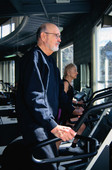
THURSDAY, May 16 (HealthDay News) — Men who are physically fit in middle age have a lower risk of developing and dying from certain cancers, new research indicates.
“Fitness is a huge predictor of [cancer] risk,” said Dr. Susan Lakoski, an assistant professor of internal medicine at the University of Vermont, in Burlington. “You need to be fit to protect yourself against a cancer diagnosis in older age.”
Men who were fit in their 40s, 50s and 60s were less likely decades later to get lung or colorectal cancer, she found. Those who were fit were also less likely to die from prostate, lung or colorectal cancers.
She is scheduled to present her research, supported by the U.S. National Cancer Institute, on June 2 at the American Society of Clinical Oncology annual meeting in Chicago.
While other studies have found physical activity protects against certain cancers, Lakoski said fewer studies have looked at the importance of fitness to predict whether men would develop or die from cancers.
For the study, Lakoski and her colleagues evaluated more than 17,000 men who had a single cardiovascular fitness assessment as part of a preventive health checkup at the Cooper Clinic, in Dallas, when they were 50, on average.
The men walked on a treadmill under a regimen of changing speed and incline. Their results were categorized into five groups, from lowest fitness level to highest.
Later on, the researchers analyzed Medicare claims data to identify the participants who had developed three common cancers among U.S. men — lung, colorectal or prostate.
The average follow-up period was 20 to 25 years. During that time, 2,332 men developed prostate cancer, 276 developed colorectal cancer and 277 developed lung cancer.
During the follow up, 769 men died — 347 of cancer, 159 of heart disease and 263 of other causes.
The men who were most fit on the treadmill test, when compared to the least, had a 68 percent lower risk of lung cancer and a 38 percent lower risk of colorectal cancer. Their prostate cancer risk didn’t decline with increasing fitness, but the risk of death from it did.
Even a small improvement in fitness helped, the researchers found. For instance, a 50-year-old man who increased fitness so he could last three more minutes on the treadmill, Lakoski said, could reduce cancer death risk by 14 percent and heart disease death risk by 23 percent.
Low fitness levels increased the risk of cancer and heart disease even in men who weren’t obese, the researchers found.
They also took into account other factors that could increase risk, such as age and smoking habits.
The good news, Lakoski said, is that, “You don’t have to be highly fit to get protection.” The most protection against cancer and heart disease was found in moving out of the least fit group.
And how unfit were those men? The men in the least fit group who were 40 to 49 when they took the test could walk on the treadmill less than 13.5 minutes. Those who were 50 to 59 lasted less than 11 minutes. Those 60 and older in the least fit group only lasted less than 7.5 minutes.
The findings make sense, said Colleen Doyle, director of nutrition and physical activity for the American Cancer Society.
“While you can’t tell just how much activity these guys were doing over time, it makes sense that the most fit would have better cancer-related outcomes — because they are likely the most active.” While the new research did not find a link between fitness levels and a diagnosis of prostate cancer, a recent review of other published studies did show a modest reduction in that risk, Doyle said.
Lakoski can’t explain the protective effects of fitness for sure, but can speculate. “We know that fitness modulates several important pathways also related to cancer risk,” she said. These include, among other pathways, reducing inflammation and oxidative damage in the cells, she said.
Doyle agreed that many mechanisms are probably at work. Activity can improve immune function, for instance, and help control weight, and that in turn can decrease inflammation, she said.
To achieve cardiovascular fitness and reduce cancer risk, be moderately active 150 minutes a week or vigorously active for 75 minutes, or some combination, Doyle advised.
Because this study is being presented at a medical meeting, the data and conclusions should be viewed as preliminary until published in a peer-reviewed journal.
Lakoski found a link between fitness and cancer protection, not cause and effect. She also can’t say whether the findings would apply to women. She hopes to study that next.
More information
To learn more about physical activity guidelines and cancer prevention, see the American Cancer Society.

